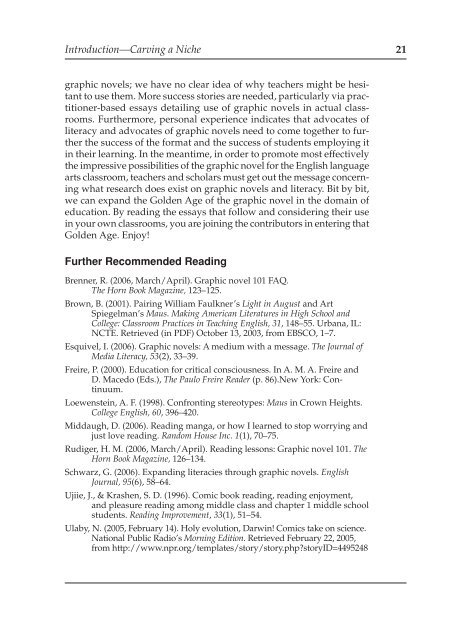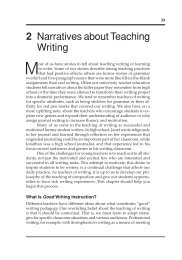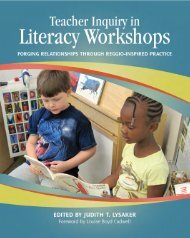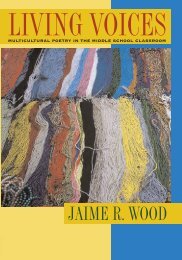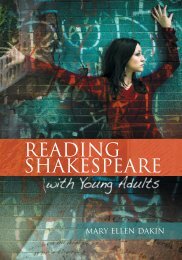Graphic novel Spread - National Council of Teachers of English
Graphic novel Spread - National Council of Teachers of English
Graphic novel Spread - National Council of Teachers of English
- No tags were found...
Create successful ePaper yourself
Turn your PDF publications into a flip-book with our unique Google optimized e-Paper software.
Introduction—Carving a Niche 21<br />
graphic <strong>novel</strong>s; we have no clear idea <strong>of</strong> why teachers might be hesitant<br />
to use them. More success stories are needed, particularly via practitioner-based<br />
essays detailing use <strong>of</strong> graphic <strong>novel</strong>s in actual classrooms.<br />
Furthermore, personal experience indicates that advocates <strong>of</strong><br />
literacy and advocates <strong>of</strong> graphic <strong>novel</strong>s need to come together to further<br />
the success <strong>of</strong> the format and the success <strong>of</strong> students employing it<br />
in their learning. In the meantime, in order to promote most effectively<br />
the impressive possibilities <strong>of</strong> the graphic <strong>novel</strong> for the <strong>English</strong> language<br />
arts classroom, teachers and scholars must get out the message concerning<br />
what research does exist on graphic <strong>novel</strong>s and literacy. Bit by bit,<br />
we can expand the Golden Age <strong>of</strong> the graphic <strong>novel</strong> in the domain <strong>of</strong><br />
education. By reading the essays that follow and considering their use<br />
in your own classrooms, you are joining the contributors in entering that<br />
Golden Age. Enjoy!<br />
Further Recommended Reading<br />
Brenner, R. (2006, March/April). <strong>Graphic</strong> <strong>novel</strong> 101 FAQ.<br />
The Horn Book Magazine, 123–125.<br />
Brown, B. (2001). Pairing William Faulkner’s Light in August and Art<br />
Spiegelman’s Maus. Making American Literatures in High School and<br />
College: Classroom Practices in Teaching <strong>English</strong>, 31, 148–55. Urbana, IL:<br />
NCTE. Retrieved (in PDF) October 13, 2003, from EBSCO, 1–7.<br />
Esquivel, I. (2006). <strong>Graphic</strong> <strong>novel</strong>s: A medium with a message. The Journal <strong>of</strong><br />
Media Literacy, 53(2), 33–39.<br />
Freire, P. (2000). Education for critical consciousness. In A. M. A. Freire and<br />
D. Macedo (Eds.), The Paulo Freire Reader (p. 86).New York: Continuum.<br />
Loewenstein, A. F. (1998). Confronting stereotypes: Maus in Crown Heights.<br />
College <strong>English</strong>, 60, 396–420.<br />
Middaugh, D. (2006). Reading manga, or how I learned to stop worrying and<br />
just love reading. Random House Inc. 1(1), 70–75.<br />
Rudiger, H. M. (2006, March/April). Reading lessons: <strong>Graphic</strong> <strong>novel</strong> 101. The<br />
Horn Book Magazine, 126–134.<br />
Schwarz, G. (2006). Expanding literacies through graphic <strong>novel</strong>s. <strong>English</strong><br />
Journal, 95(6), 58–64.<br />
Ujiie, J., & Krashen, S. D. (1996). Comic book reading, reading enjoyment,<br />
and pleasure reading among middle class and chapter 1 middle school<br />
students. Reading Improvement, 33(1), 51–54.<br />
Ulaby, N. (2005, February 14). Holy evolution, Darwin! Comics take on science.<br />
<strong>National</strong> Public Radio’s Morning Edition. Retrieved February 22, 2005,<br />
from http://www.npr.org/templates/story/story.phpstoryID=4495248


